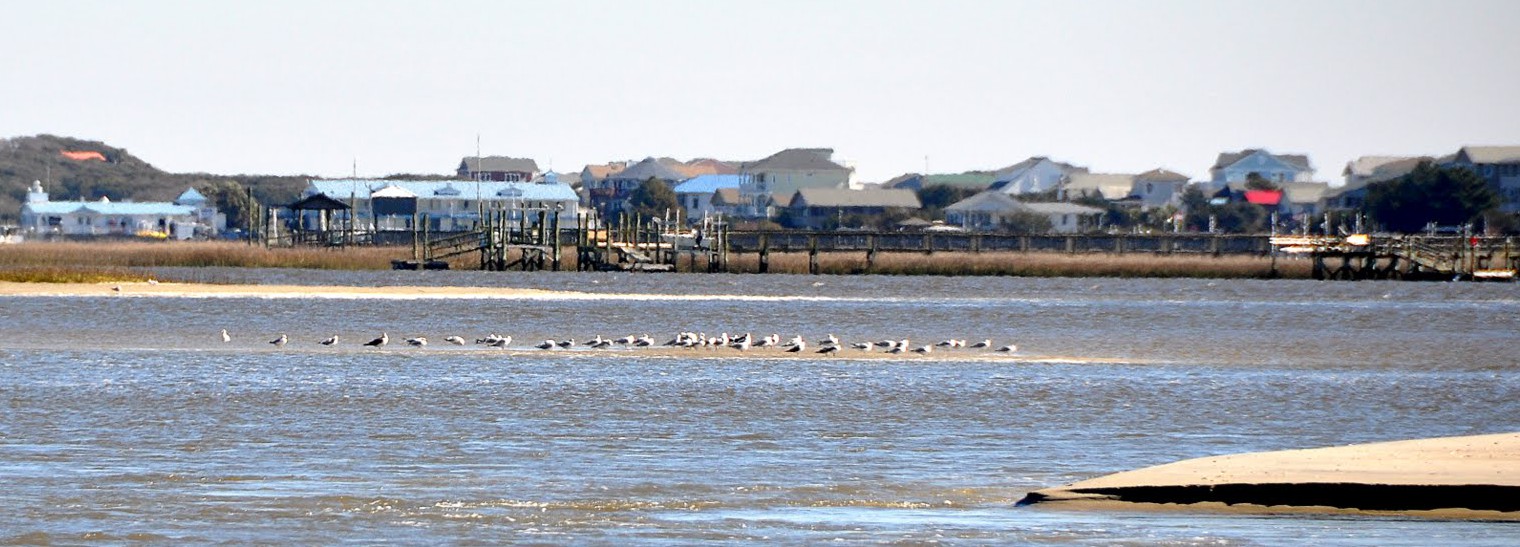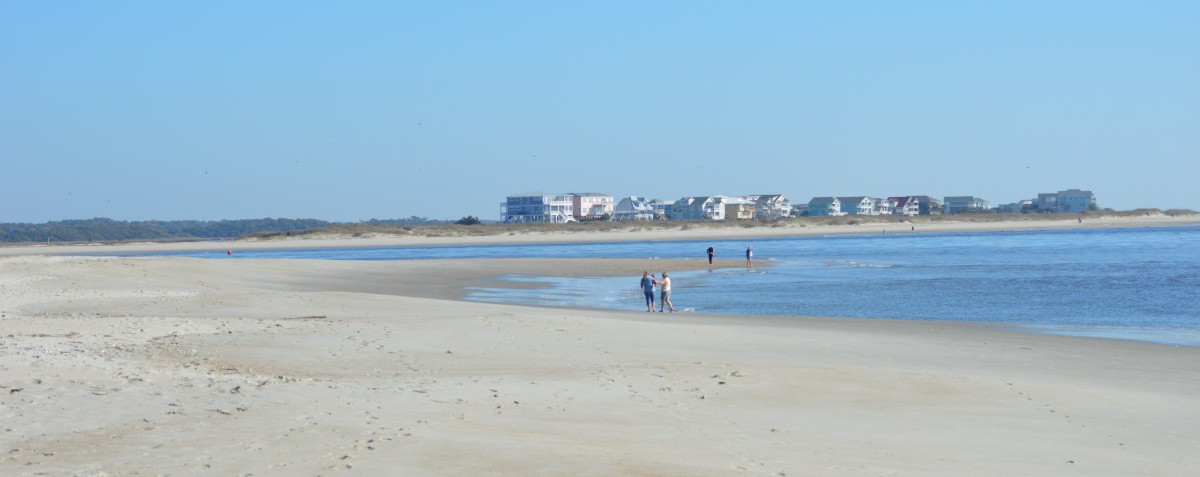UPDATE: Holden Beach’s Board of Commissioners unanimously voted to revoke the town’s permit applications for a terminal groin on April 17. The Corps announced April 19 that it is no longer seeking public comment and has ceased its permit review of the town’s application.

“It is great news that the town will not be pursuing this destructive process. Town officials have been receptive in listening to the negative impacts of a terminal groin, which are extremely expensive and not guaranteed to work.”
Todd Miller, executive director
Background
The Issue
Lockwood Folly Inlet belongs to the people of North Carolina. After the North Carolina General Assembly in 2011 passed a law that allows five terminal groins to be built on North Carolina beaches, the town of Holden Beach applied for a permit to construct one near Lockwood Folly Inlet.
Should the terminal groin move forward, property owners at Holden Beach will be left with a long-term financial burden in an effort to control erosion. Constructing a terminal groin would bisect the public beach, impede public access and destroy the natural systems that make the Lockwood Folly Inlet and surrounding beaches productive and accessible. Terminal groins can cause unintended consequences that harm the public beach, further erode downdrift of the inlet and potentially increase the risk and erosion in the central reach beach project and put other property owners at risk.
What’s at Stake
Critical habitat: The adjacent critical bird habitat at the east end of Holden Beach could be negatively affected and intertidal areas of the inlet so critical for fisheries and other wildlife will be permanently affected by this rock structure robbing areas of sediment and changing the inlet morphology forever.
Public access & recreation: The proposed massive rock structure will impede public access used by thousands of people every year for fishing, swimming and sunbathing. This proposal will protect only a few homes risking other properties elsewhere on the island and damaging forever the public trust resources on the beach and the inlet.
The Cost
A terminal groin is expensive to build and to maintain. The information from the Army Corps of Engineers draft Environmental Impact Statement (EIS) was insufficient to support the decision to build a terminal groin. The estimated cost for constructing a terminal groin, presented at the public hearing in April, is extremely low compared to what similar structures are estimated to cost elsewhere. The number of lots the groin will protect is also low, less than 20 at best.
Updates
Comment letters & fact sheets from the campaign:
- Lockwood Folly Inlet Fact Sheet
- Read the comment letter from the North Carolina Coastal Federation.
- Read the comment letter from the Southern Environmental Law Center.
- Read the comment letter from Audubon North Carolina.
Resources:
- The Army Corps of Engineers’ Final Environmental Impact Statement — scroll to Corps ID # SAW 2011-01914 (March 2018)
- U.S. Fish and Wildlife Service’s Biological Opinion required by the Endangered Species Act (July 2016)
- The Army Corps of Engineers’ Draft Environmental Impact Statement (August 2015)
- A Fiscal Analysis on Shifting Inlets and Terminal Groins in North Carolina (Andy Coburn, November 2015)
- North Carolina’s Terminal Groins at Oregon Inlet and Fort Macon (Stephen Underwood, Division of Coastal Management 2010
For more background information, check out these articles:
- Holden Beach public forum
- Coastal Review Online: Holden Beach groin study out for review
- Oppose Holden Beach terminal groin
- Coastal Review Online: Will beach towns seize property?
- Coastal Review Online: Same tune, different players at Holden
- Coastal Review Online: Group blasts town’s terminal groin
FAQ
What exactly is a terminal groin?
A terminal groin is a rock, concrete, stone or metal structure built on the side of an inlet at the end (terminus) of an island, perpendicular to the coast.
How does a groin work?
Groins trap some sand by blocking the current as it moves along the beach. Once about two or three hundred yards of sand is trapped, sand can move around the groin depending on the groin length, size and inlet geology. Groins do not prevent sand from entering inlets and channels, and are not designed to help with navigation.
Are groins and jetties the same?
No. Jetties are longer than groins and they are built for navigation purposes. Groins are built to try to keep a barrier island in place and to try to prevent erosion of beaches.
Why does Holden Beach erode?
Holden Beach is a barrier island, bordered by two tidal inlets, one on the east end and the other to the west end of the island. This island/inlet system forms nature’s most dynamic coastal environment, and is prone to natural movement and change. Coastal geologist Dr. Stan Riggs describes inlets as “self adjusting safety valves” that adjust to tides, water levels and storms, as well as provide a natural response to changing conditions. Inlets open and close when storms occur, and as they move sand shifts. This movement and sand shifting is what causes erosion of some areas of barrier islands and accretion of others. Engineering an inlet by adding a hardened structure causes the inlet to lose its ability to self adjust, and the result is increased erosion and negative effects on the natural system. Terminal groins can cause unintended consequences along the beaches, the inlet, adjacent island and interior wetlands and intertidal habitats.
Will a terminal groin protect the island from hurricanes?
No. Groins are not meant to protect the island or the structures on it from hurricanes. In fact, they are as susceptible to hurricanes as any other structure on the island. They could cause unpredictable erosion damage because they can channel floodwaters in unnatural ways.
What is the cost to install and maintain a terminal groin?
The official study conducted by the State of North Carolina estimated that over 30 years a groin like the one in Holden Beach could cost up to $50 million. However, Holden Beach has assessed its terminal groin to cost only about $34 million over the 30-year period. This cost does not include maintenance and eventual removal of the structure.
How will building a groin on Holden Beach affect the turtles and birds that nest on the island, as well as other animals that use this area as habitat?
Building a terminal groin on Holden Beach would harm some of the island’s irreplaceable natural habitats. The beaches and waters of Holden Beach are used by 14 federally endangered or threatened species, including several bird species that forage and nest on the east end of the island. Endangered sea turtles also use the sandy beaches for nesting. The groin would change the low sandy habitat of the east end of Holden Beach into a dune system. This habitat will not support the needs of the animals that currently use the sandy shore of Holden Beach. Many shorebirds that migrate to this area each fall would lose their winter habitat. A terminal groin on Holden Beach could cause erosion and loss of habitat on Oak Island as well.
Does building a terminal groin mean beach renourishment will no longer be necessary?
No. The beach will still have to be nourished even if a groin is built. In case of Holden Beach renourishment will be necessary every four years, if not more frequently.
Will a groin reduce the need to manage Lockwood Folly Inlet?
No. State law requires an inlet management plan to accompany all terminal groin project proposals. There are currently no terminal groins on shallow water inlets in North Carolina. However, engineers who have studied the concept of this type of project have determined that it will be necessary to manage inlet channel location for a terminal groin to have any chance of working as intended.
Will Lockwood Folly Inlet still need to be dredged?
Yes. As with inlet management, dredging will still be necessary. This is mainly because groins are not meant to stabilize an inlet, but to stabilize beaches adjacent to inlets. This is why the state legislature requires inlet management plans for groin proposals. In fact, this continued need to manage and dredge inlet channels led the Carteret County Beach Commission to decide not to pursue their terminal groin project at Bogue Inlet because it would not be cost-effective alternative to current management strategies.
Won’t the public beach disappear if the groin is not built?
Sandy beaches move around and will always be there no matter how the inlet moves in a natural system. If a groin is built this will no longer be the case. The groin will completely wash away the sandy spit when the inlet channel migrates up against it. The loss of this area will also limit public beach and boat access for many families that regularly enjoy this natural area.
What will happen to Holden Beach if a terminal groin is not built?
Holden Beach has remained in a similar position for over 200 years (probably longer, but records don’t go any further back). History has shown that the island has always recovered from occasional periods of erosion. There are softer alternatives than building a groin that will allow for natural processes to continue and for the natural habitat to keep evolving as it always has. There is no need for a groin, so the prudent economic and environmental decision would be to do nothing and address any erosion that might take place with more viable alternatives and with better science than what is provided in the draft EIS.

